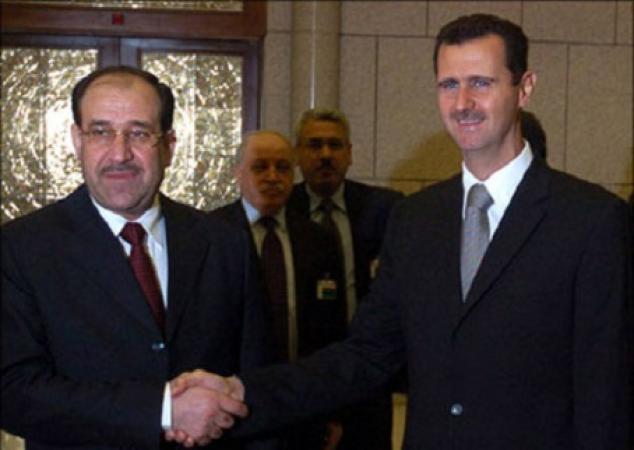PHOTO: Iraqi President Nuri al-Maliki and Syrian President Bashar al-Assad
A marginalized Sunni population becomes increasingly disillusioned with an Iranian-backed, Shia-led government. Against this backdrop, Islamic extremists linked to Al Qa’eda take the initiative and seize swabs of the country’s Sunni heartland. The government strikes back and responds that it is engaged in a war against terrorists.
This scenario can describe both Syria and Iraq today. Legitimate Sunni grievances have opened the gate for extremists in both countries.
Yet the US response is markedly different towards these similar situations.
In Syria, the US has condemned the Assad regime’s crackdown on the largely -unni rebellion. It cast the situation as an oppressive government brutally suppressing a legitimate uprising. There has been some non-lethal support to the rebels, and the U.S. even came close to using military force against Damascus in response to last August’s use of chemical weapons.
In Iraq, the US supports Baghdad’s efforts to push back against recent gains by the Al-Qa’eda linked Islamic State of Iraq in Anbar Province, particularly in the cities of Fallujah and Ramadi. As Secretary of State John Kerry recently stated, “We will stand with the government of Iraq and with others who will push back against [ISI’s] efforts to destabilize and…to wreak havoc on the region and on the democratic process that is taking hold in Iraq.” Short of sending in boots on the ground, the U.S. seems willing to provide the Iraqi government with the weapons and support it needs for the fight.
The divergence between these two responses demonstrates the problem with the narratives the US has built, and it points to greater problems within each country.
In Syria, a largely peaceful uprising has been supplanted by the danger of Al Qa’eda-linked militants taking over parts of the country. Alongside the brutality of the Assad regime, these Islamic extremists are also committing massacres in Syria, including against others in the opposition and insurgency.
What started as a democratic revolution has turned into a civil war within a civil war, between moderate and extremist rebels.
In Iraq, ISI has been able to return because of the grievances the Sunni population feels towards the Shia-led Government in Baghdad. After working to drive ISI out during the so-called Anbar Awakening, many Sunnis feel that they were rewarded with hostility from Prime Minister Nuri Al-Maliki.
Instead of reconciliaton, the Government prosecuted in absentia and sentencing to execution Vice President Tariq al-Hashimi, a Sunni. The trigger for the current crisis was the crackdown of an anti-government protest camp in Ramadi, the arrest of a Sunni MP, and the killing of his brother.
So why did Washington take differing courses of action in the two cases? The answer lies in the evolution — or devolution — of the crises.
When the Syrian uprising began in 2011, it was part of the broader Arab Spring which brought the hope of democratic change to the region. Relations with Iran were at a low point, given the diplomatic stalemate over its nuclear program.
Following the move towards an armed uprising, it appeared that the Assad regime was in danger of quickly falling after defections and loss of territory. Supporting the Syrian uprising seemed like an easy decision, given the desire for the Arab Spring to continue and the prospect of weakening Iranian influence in the region.
The situation in Iraq took place in the context of the Obama Administration’s desire to reduce U.S. military presence around the world. With large-scale reductions in violence during Obama’s first term, the US may have been overly optimistic that it had “won” the war in Iraq and stabilized the country. As a result, Washington may have given the Maliki Government too much of a free hand to crack down on legitimate dissent.
Now Syria has bogged down in what seems to be perpetual civil war, with neither the rebels nor Assad being able to deliver a knockout blow. Worse, Islamic extremists have gained territory and may use it as a base to launch attacks against the West.
Meanwhile, negotiations with Iran over its nuclear program appear to be yielding results. Potential military action against the Assad regime or greater support for the rebels would complicate attempts at rapprochement with Tehran.
Iraq faces the threat of once again falling into the sectarian abyss, with the return of large-scale violence. Porous borders have fed the danger of a regional civil war between Sunni and Shia from Beirut to Baghdad.
The image of Iraqi cities, where many Americans died fighting, falling back into the hands of “Al Qa’eda” militants is not how the Obama administration wanted to ring in the year.
So, for all the differences in the Obama approach to Syria and Iraq, a convergence seems to be immminent: a response to the threat of “extremists” challenging the ruling elite. At the same time, the underlying issue of problematic governments in both countries has to be addressed for any long-term solutio.
Can the US do that before, given the transnational nature of the conflicts, the challenge moves beyond just “Syria” and only “Iraq”?
About the author:
Sam Shirazi currently attends the University of Virginia School of Law, where he is a managing editor for the Journal of Law and Politics. He has worked for a prominent international law firm and for the US Department of Justice. Born in Tehran, Iran, he grew up in Los Angeles, California.

